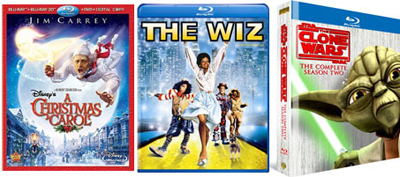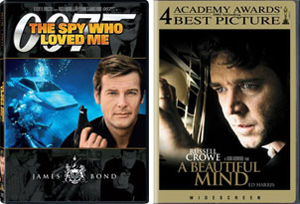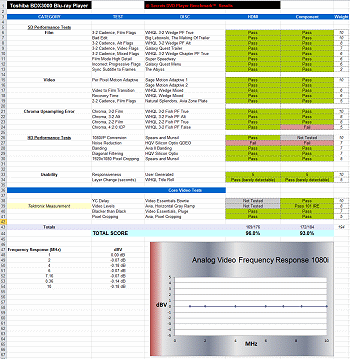Introduction
By now you’ve heard lots about 3D TVs. Every manufacturer has at least one 3D-capable model and even the projector companies are offering new products that include this technology. The display is not the only component required to view 3D however. You will also need, at a minimum, a new Blu-ray player. The format itself has not changed but a 3D model is required to view Blu-ray 3D discs. No matter what the brand, every 3D flat panel has a companion player. In the case of the Toshiba WX800 Cinema Series LED panel, recently reviewed at Secrets, that player is the BDX3000.
Specifications
- Design: Blu-ray Universal Player
- Supported Disc Types: BD-Video, BD-3D, DVD-Video, CD, AVCHD, CD-R/RW, DVD-R/RW, BD-R/RE
- Audio Codec Support: PCM, Dolby Digital, Dolby TrueHD, DTS, DTS-HD Master Audio
- Audio Output: LPCM, Bitstream, Bitstream Mix
- Internet Apps: Blockbuster, Netflix, Pandora, Vudu
- BD-ROM Profile 2, Version 2.0 & Profile 5, Version 3 (3D)
- Audio Connections: 7.1 RCA, TOSLink, 2-channel RCA
- Video Connections: HDMI 1.4, Component, Composite
- Supported Video Resolutions: 480i/p, 720p, 1080i/p
- 24p Output: Yes, for Blu-ray only
- Additional Connections: Ethernet (100BASE-T)
- WiFi 802.11n
- Dimensions: 2.5″H x 16.9″ W x 8.25″ D
- Weight: 3.9 Pounds
- MSRP: $279
- Toshiba
When I requested the WX800 TV, Toshiba included the BDX3000. Without it, I would have only been able to use the panel as a standard 2D display. This and the glasses are the minimum compliment of gear you’ll need to view 3D Blu-ray content. If you want lossless sound from your 3D Blu-rays, you’ll also need an HDMI 1.4 receiver or pre-pro. And of course, don’t forget the glasses! In Toshiba’s case, they are sold separately from the player and the panel.
The BDX3000 is Toshiba’s top-of-the-line player. In addition to 3D, it offers a suite of Internet apps with built-in WiFi. Since 3D content is pretty scarce right now, I was anxious to see how the BDX stacked up in more relevant areas like DVD up-conversion and ergonomics. Apps are a new feature appearing now on many players and TVs so I looked forward to checking them out as well. So, here we go.
Design
The BDX3000 looks no different than Toshiba’s other players. It’s a 17-inch wide box that will fit any standard rack or shelf unit. It’s only 8.25 inches deep though, so cabling will be a little tricky if you use a rack. The power cord is not removable. The front panel is smooth with no traditional buttons at all. Only the cutout for the disc tray breaks up the landscape. At the center is a backlit Blu-ray logo which can be dimmed with a button on the remote. To its immediate right is the status panel which conveys the usual track and time information as well as output resolution and disc format. Continuing right are the touch-sensitive controls. These were annoying to me as they only light up when you touch the panel first. Then you have to touch the appropriate control again to execute. It was easier to simply use the remote for opening and closing the disc tray. I usually prefer the front panel control for this but the double-tap required by the BDX got old after awhile.
The back panel has a full set of connections. Besides HDMI 1.4, there is a TOSLink output, 7.1 analog RCA jacks, a LAN connection and a USB port for flash drives. Analog video outputs include component and composite. Finally, there is a two-channel analog audio output separate from the multi-channel ones.
Internally, the BDX is nothing out of the ordinary. All Blu-ray profiles are supported right up to BD version 3, profile 5.0 which adds 3D to the list. Of course this means BD-Live and Bonusview, something which all players now offer. On the audio side, both bitstream and PCM output is supported so you if you have a receiver that is LPCM-compatible, you can still enjoy the full detail of the lossless Dolby TrueHD and DTS Master Audio codecs without upgrading. I’m proud to say I’m still using a Denon AVR-3806 in my living room system with its now archaic HDMI 1.1 inputs; all two of them. It handles lossless audio just fine after four years on the job!
Another major feature set of this player is Internet apps. The BDX has built-in WiFi compatible with all major wireless standards up to 802.11n. Apps include Netflix, Vudu, Pandora and Blockbuster. This is becoming a common feature in both Blu-ray players and TVs now. The added WiFi is nice since you don’t have to run an Ethernet cable or add some sort of wireless bridge. The WX800 TV required me to add a WiFi adapter to access its Internet features.
In addition to Blu-ray and DVD, you can play Redbook CD, writeable DVDs and CDs and data discs. SACD and DVD-A are not supported. Compatible data formats are AVCHD, MP3, Windows Media Audio and JPEG. The files can reside on a disc, SD memory card or USB thumb drive. The SD card slot is conveniently located on front panel in the lower right corner. If you want to use the USB port, you’ll have to reach around back. This is probably your best bet if you want to use BD-Live with this player. It does not have any internal memory so you’ll have to use either an SD card or a USB stick of at least 1 gb capacity.
The remote is much like the wands that come with other Asian-built players. It is not backlit which makes it frustrating to use in a darkened room. The buttons are grouped by function and have different shapes alleviating some of the fumbling when the lights are off. At the top is the power toggle followed by the eject button and keys for display-related functions. Next is a row of round buttons to access the disc menus. In the center is the navigation cluster. Below that are the transport keys. These were all the same shape and I had a hard time remembering the layout. Here’s where a backlight would have really helped. At the bottom is the customary numeric keypad.
Setup
Installing the BDX3000 is just like setting up any other Blu-ray player. You’ll need a 3D display obviously, if you want to use that feature. For most of the review, the BDX was connected to Toshiba’s WX800 LED TV. Despite the higher bandwidth required by the HDMI 1.4 interface, I had no trouble using one of my trusty Blue Jeans cables. If a dealer tries to convince you to buy a new pricey HDMI cable for your 3D setup, tell him you’d like to try your old cables first. Chances are they’ll work just fine. I also plugged in an optical cable to test the player’s musical abilities.
The menu system is easy to navigate with a tree-style interface that progresses from left to right as you drill down through the options. The main menu is split into Settings and Connected which accesses all the player’s Internet features. I’ll talk about those a bit later. One thing I did not like was the menu’s sluggish response to remote commands. There is no flipping quickly through settings with this player. Each key press takes at least two or three seconds to execute. That includes merely scrolling down a list of options. I don’t know if the remote or the player’s firmware is the culprit here but it sure was annoying.
To set up the player you can opt for a Quick Setup which selects the language, resolution, aspect ratio, wireless, disc auto play and the screen saver duration. If it is your first time turning it on or you’ve done a factory reset, you’ll be presented with Quick Setup automatically. You can bypass it and run through all options manually of course, which is what I did.
Display options extend to setting the output resolution, aspect ratio, film mode, deep color and the 3D mode. Output resolution usually works fine when set to Auto but I prefer to force 1080p just to be safe. TV Aspect will nearly always be 16:9 Pillarbox which shows 4:3 DVDs correctly with bars on the left and right. Film Mode is the 24p option and you’ll want to set that to on if your display accepts that rate as most do nowadays. I discovered leaving this on when streaming content from Netflix results in extreme judder. I believe this is a design flaw since you have to go to the setup menu every time to turn Film Mode off when you want to stream. You can turn on Deep Color if you want to output video at 4:4:4 or 36 bits-per-pixel. This is a setting I always turn on when possible and the BDX handled the color up-conversion perfectly. Blu-ray 3D Mode should be left on Auto if you want 3D discs to show correctly. You can force 2D if you want.
Moving on to Audio settings we have PCM Downsampling (48 or 96kHz), Digital Output, Dynamic Range Control and Stereo Downmix. Digital Output is where you’ll choose bitstream or PCM output. If you have an HDMI 1.3 or later receiver, you can let it handle the decoding by choosing bitstream. Choosing PCM relegates decoding duties to the player. There were two other choices here I had not seen before, Bitstream Legacy and Bitstream Mixed. Legacy sends a DTS or Dolby Digital feed from the core track encoded on every Blu-ray disc. Mixed will add in menu sounds and PIP audio and send a DTS stream to your receiver. Choosing either one of these means you won’t experience lossless audio. Dynamic Range Control can be set to On, Off or Auto. Auto means the compression will be applied to all audio codecs except Dolby TrueHD. In that case, compression will be applied if the correct flag has been set during the disc authoring process. Finally, Stereo Downmix processes multi-channel audio to the two-channel analog outputs. You can have straight stereo or a surround encoded version that is compatible with older Dolby Pro Logic receivers and processors.
If you are using the analog multi-channel outputs, the speaker setup is limited to choosing large or small for each channel and setting the sub crossover. There is no adjustment for delay or level. I have to wonder why Toshiba bothered with analog outputs when they have provided no proper way to calibrate a surround system.
The Language Setting menu lets you change options for the on-screen menus and the default language used with discs and the subtitles. The Parental Control menu gives you the option of blocking content past a certain MPAA rating. Once configured, this setting can be locked with a four-digit numerical password. The final menu is called System Setting. Here you can toggle Auto Play, set the time zone, choose the screen saver duration, toggle the CEC control support or update the firmware. This can only be done over the network, not from a USB device or SD card. Normally, the player will prompt you when it finds a new update. You don’t have to check for them manually. You can also reset all options to their factory defaults.
In Use

A lot of my time with this player was as part of the WX800 TV review I did recently. There isn’t much to say about 3D content specifically since its quality is dependant on the display, not the source. The only movie I watched in 3D after the TV review was finished was A Christmas Carol. I do want to cover it here because it is easily the best 3D content I have viewed to date. This description is more a follow-up to the WX800 article than it is an example of the BDX player’s abilities. Simply put, A Christmas Carol looked fantastic. All my previous observations about the crosstalk and lack of image clarity were largely forgotten with this disc. The ghosting was not completely gone but it was so minimal I barely noticed it. Mind you, it was only the fifth 3D title I’ve been able to get my hands on. There just isn’t anything out there yet. If you’re investing in the format be warned, content selection is EXTREMELY limited at this time. The release of this disc was quite well-timed for the holidays and I enjoyed it thoroughly. Not only was the image near reference-level, it was obvious Disney knows how to best use the format. Resolution was always retained even in fast-moving action scenes. Objects always had a clear place in the z-axis never being too far in front of or behind the screen plane. Obviously any 3D Blu-ray player will render this film equally well but I have to take this opportunity to let you know what I saw.
For the remainder of the review period, I connected the BDX to my main theater system which consists of an Anthem LTX-500 LCoS projector and an Integra DHC-80.1 processor. The 80.1’s video output was set to pass-through so all video processing was handled by the player. I watched a few Blu-rays and DVDs. I also listened to some music utilizing the optical connection. I always prefer TOSLink or coax over HDMI for music reproduction due to its lower jitter.
The Wiz is a recent Blu-ray reissue and Universal has done a decent if not stellar job blowing the dust off this 32-year-old film. The image looked as solid as I’ve seen on any other player; including the Oppo BDP-83. Film Mode was engaged to get the proper 24p frame rate from the disc. The DTS-HD Master Audio encode is the best thing about this release and it sounded excellent through the BDX-3000. Big musical numbers were rich and dynamic with lots of punch and pizzazz. Obviously this player gives nothing away to its competitors in the Blu-ray audio department. I used the BitstreamHD output and let my Integra DHC-80.1 handle the decoding duties. I observed no dropouts or artifacts of any kind.
Star Wars: The Clone Wars, animated series is one of my favorite references for testing displays and players. No surprise, Blu-ray performance in all aspects was exemplary. The bright bold colors popped just as they do when I play this disc in my Oppo. The painted textures used in this CGI presentation showed an appropriate level of grit and grime on the storm troopers’ uniforms as well as other surfaces. The sound was also excellent. Even though the encode is only Dolby Digital, it had tremendous depth and slam especially during the many battle sequences. The BDX had no trouble with the extreme LFE information as my very-large Axiom EP-800 sub shook the walls with its usual aplomb.

On DVD I watched the James Bond classic, The Spy Who Loved Me. This disc is part of the Lowry Digital restorations released a few years ago. It has unfortunately not made it to Blu-ray just yet. This particular transfer is not quite as stellar as others in the set showing a little softness and obvious edge enhancement. On the BDX, it looked decent, in fact, not too far from my reference Oppo. The ringing was a little more pronounced and the detail a tad softer but scaling and deinterlacing seemed OK. As I mentioned earlier, the Film Mode does not work for DVDs so no 24p mode is available. This makes a bigger difference for me than resolution. I was able to use the 24Hz mode in my Integra pre-pro without trouble.
A Beautiful Mind has several torture tests including side-pans and images of stained glass windows that will show crawl and breakup on poor-performing players. I did not see these issues from the Toshiba. The picture was reasonably sharp and pans did not show any excessive resolution loss. There was the usual 3:2 judder of course but this is no worse than any other player I’ve tested recently. Given the performance I observed, the BDX3000 will do a fair job with DVD up-conversion. For more detailed information, please refer to the benchmark tests in the next section.

I started my music listening with a bit of Strauss in the form of his lush and beautiful wind concerti. This is a superb recording that I have listened to many times. The BDX did a passable job over its optical connection. I did miss that last nth degree of detail and transparency I’m accustomed to but then classical music shows this more than other genres. The music was still rich and dynamic with a strong low end. The Toshiba gave away little to my Oppo player. Only the tiniest bit of detail distinguished the two presentations.
I recently purchased the Beatles stereo remasters and have been re-discovering my youth by listening to all the albums. I played a few of these records when I was growing up and the music is now so wonderfully familiar. These recordings sound amazing especially given their age. I listened to Sgt. Pepper’s Lonely Hearts Club Band and found myself enjoying the entire album before I realized how much time had passed. The recordings are that engaging and they sounded every bit as good played on the Toshiba as on any other source. My recent switch to coax or optical connections for music rather than HDMI has really opened up a new horizon in my listening room. Not only are dynamics greatly improved, the detail and imaging is worlds better. The Beatles’ stereo recordings frequently image many instruments to one channel or the other. It’s neat to hear George Harrison’s guitar coming only from the left channel or a keyboard riff firmly anchored in the right. The Toshiba did a fine job preserving the artists’ and engineers intent.
Like many Blu-ray players in the current generation, the BDX3000 offers Internet apps in the form of Netflix, Vudu, Pandora and Blockbuster. Since the only one of these I subscribe to is Netflix, I could only try that app. Setup was the essence of simplicity. The player generated a code which you then enter on your computer (I used my iPhone) to get connected. The titles in your streaming queue appear on the screen in a side-scrolling chain with cover art. Selecting a title brings up a synopsis and the runtime info. Playback starts a few seconds after the app measures your connection speed. I got 10 of 13 bars over my 802.11n network, not bad at all. Quality varies widely depending on the movie or TV show you’ve chosen. Some episodes of Dirty Jobs bordered on unwatchable due to macroblocking and other artifacts. Zombieland showed decent resolution but there were frequent frame drops and periods of judder. That’s when I realized the flaw was with the player’s Film Mode setting. Once I turned it off, the image was much smoother. It is strange that 24p doesn’t work with DVDs but it does engage with streamed content. Too bad it doesn’t work! I don’t recommend using the Netflix streaming service with a projection setup. The image just doesn’t hold up on the big screen. A TV 50 inches or smaller is OK if you’re not sitting too close. None of this is the fault of the BDX3000.
One aspect of player performance I should touch on is ergonomics. Most Blu-ray players perform equally on Blu-ray content and do a fair job with DVD up-conversion. There is a greater divide when comparing usability and responsiveness. On this score, the Toshiba did not fare too well. Loading discs was good and response to remote commands was OK when a transport key was pressed but menus displayed only after a delay of several seconds. Ejecting a disc was also very slow. It usually took at least 10 seconds after I pressed the button before the disc finally emerged. Moving in and out of the Netflix app was also sluggish. It took 17 seconds for my queue to appear and another 24 to return to the player’s home menu. Other than the poor response times, I had no other problems with the BDX3000. It never failed to read a disc and no lockups were observed.
On The Bench (Stephen Hornbrook)
These measurements were taken with a Tektronix Oscilloscope from the analog component outputs. Overall the BDX3000 did quite well, as I measured a peak output of 101 IRE which we consider within spec. YC delay on the bowtie test looked very good as well, with a very flat response. The Toshiba was also able to pass the blacker-than- black PLUGE test. The BDX3000 displayed full 1920×1080 resolution without cropping any pixels on the left, right, top, or bottom. (Click on the graph to make it larger for viewing, mouse over the larger graph and then click on the blue square in the bottom right hand corner to enlarge it to full size. Click the graph again to reduce it back to its original size on the page.)
HD performance was very good from the Toshiba. It passed the important jaggies tests with excellent picture quality. I was not able to test noise reduction since I couldn’t find any settings for it on the player. It did not appear to be performing any sort of noise reduction on our tests.
Standard DVD performance was excellent as the Toshiba BDX3000 passed all our deinterlacing tests. The high detail Super Speedway clip took less than half a second to lock on, and once it did, it looked great. Switching from video to film was done correctly, but the transition was visible for a split second. 2:2 video was also handled correctly. I did notice some blocking on the Chroma ICP test via component.
On the usability side, I did feel the menus were a bit sluggish and non-responsive. At times the delay was a bit frustrating. However, the layer change time was almost undetectable.
Conclusions
My overall experience with the BDX3000 was a good one. Blu-ray video and audio performance was on par with every other player I’ve tested. DVD up-conversion was better than average at this price point and music playback over the TOSLink connection was decent. The only real flaw was poor ergonomics. Scrolling through menus was just too labor-intensive when the player couldn’t keep up with the remote. I also didn’t like the lack of traditional buttons on the front panel. I’ve seen several components from different companies with touch-sensitive controls and I don’t like any of them. Please give us real buttons!
The Internet apps are somewhat crude and sluggish but it’s hard to find too much fault since Toshiba includes WiFi. Adding 3D to the mix at least will make you ready for the future if 3D is indeed it. It’s hard to say what will happen until more content is made available but if you want 3D now, a player like the BDX3000 is a necessity. As a convergence component, it competes favorably with similar offerings from other companies. The Internet thing is still new to consumer electronics and I haven’t seen any products really stand out yet. Compared to a more refined device like the Apple TV, these players have a little work to do yet.
At $279, the BDX-3000 is at the upper end of Blu-ray player prices but it offers everything the competition does at that level. With solid audio and video performance, you won’t regret adding this player to your system. Recommended.





